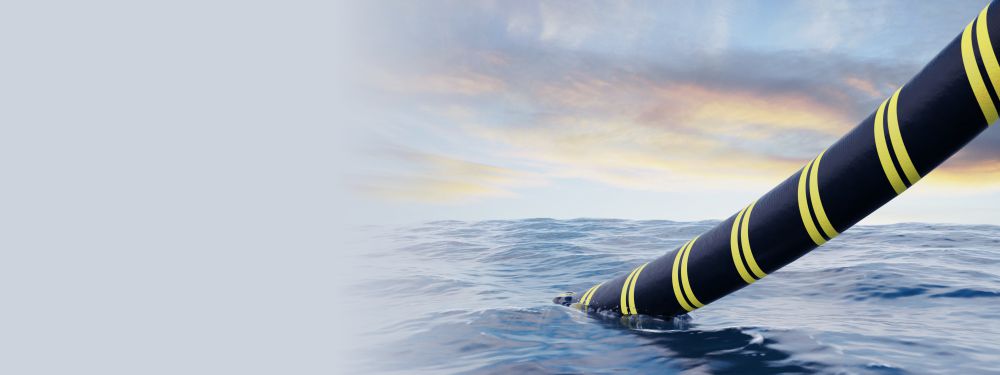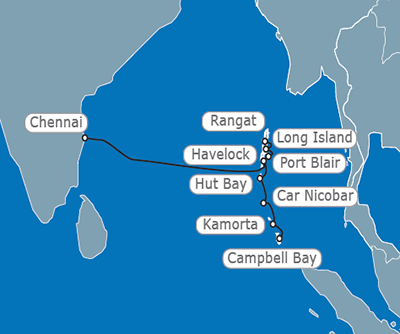India
Breadcrumb navigation
NEC builds 2300 km long submarine cable connecting Andamans and Nicobar Islands to ChennaiCANI Case Study![]()


Introduction
To the east of the Indian subcontinent lies the Andaman and Nicobar Islands, an archipelago complete with pristine beaches, plantations, and picturesque scenery. It is an ideal setup for tourism and small-scale industry-led economy to thrive. However, due to the minimal digital network, it was considered as an 'off-the-grid location. The only medium for providing telecom connectivity between the mainland and Andamans was through satellites with bandwidth availability limited to only 1Gbps.

Additionally, being an island territory, the region was also prone to floods and natural disasters. With no alternate medium to establish connectivity, it was also challenging for the authorities to facilitate emergency operations efficiently. Therefore, a need to build a robust telecom infrastructure, connecting even the remotest of the locations on the islands was felt, and the Chennai-Andaman & Nicobar Islands (CANI) submarine optical fibre cable project started taking shape.
The ambitious goal to thread the islands to the mainland through a high-speed optical fiber cable network started in 2018. Fibre optic cables are one of the most cost-effective transmission modes and offer improved compatibility, robustness, and efficiency to the system. Under the DoT (Department of Telecommunications) initiative, BSNL awarded NEC India to design, engineer, supply, install, test and implement an optical submarine communication system that connected A&N islands to Chennai. The project included building a segment with repeaters from Chennai to Port Blair and seven segments without repeaters between the islands of Havelock, Little Andaman (Hutbay), Car Nicobar, Kamorta, the Great Nicobar Islands, Long Island, and Rangat. The total cable length extended to approximately 2,300km and carries 400 Gb/s optical waves in the S1 segment, connecting Chennai to Port Blair and 200 Gbps in the rest of the segments.
Challenges
Magnitude
The construction and laying of the CANI was a formidable task and involved a series of actions. Right from measuring a massive length of 2300 km to assessing the exact path for laying the cable, the process required precise planning, considering underwater topography and previously recorded obstacles.
Seafloor Variance
The seafloor depth naturally varies, and both very deep and very shallow waters bring their own challenges. The submarine cable needs to be able to endure the tremendous pressure of extreme depths, including deep trenches. At the same time, at shallow depths, it needs to be hard enough to withstand being struck by anchors.
Pandemic
As the project started to unfold, the country was struck with the Corona pandemic, and the supply chain network stood ruptured. With strict lockdown protocols and slow material and manpower movement, it got difficult for the team to obtain approvals for laying cables, especially in the COVID-sensitive areas.

Solution

NEC is recognized for its excellent track record and dependability when it comes to building complex cable systems in challenging marine environments. With over 50 years of experience in optical submarine cables, NEC has constructed some of the largest cable networks in service today. The team understood the challenge at hand, took assistance from local authorities to speed up the cable layout action plan. With the team's resilience, perseverance, and immense support from the client and the concerned authorities, the CANI project took to speed overcoming the COVID issues.
To overcome the Magnitude and terrain challenges, submarine repeaters were installed every 60-100 km to amplify and maintain the strength of transmitted signals, thereby ensuring stable transmission even over such a long distance.
The project was carried out very cautiously by the team, with the speed and angle being constantly adjusted and crew members remaining on board for months to enable the successful completion of the project.
Result
The team delivered the project in September 2020, much ahead of its December 2020 deadline, connecting even the remotest locations of the island with Chennai. "Being the main contractor of the project, NEC has shown exemplary commitment in completing the project despite enormous challenges posed by Covid-19 pandemic, and the entire team deserves accolades for this achievement. This has been possible only because of the extreme devotion, planning, and coordination skills shown by the organisation in accomplishing this task at hand”, said V Munindra Nath, Chief General Manager, BSNL
The project will spearhead India's "Digital India" vision by extending and enhancing business opportunities in the region, thus empowering the island both economically & socially. Furthermore, the hyper-connectivity brought by the submarine network would strengthen online education, telemedicine, e-commerce, net banking facilities, and tourism in the island territory, opening doors for the islanders towards better lives and opportunities.
“The CANI project has been one of the most prestigious projects implemented by NEC in India. As a result of the immense experience and capability gained by the team through this project, NEC India has firmly established itself in the Global S Submarine Business Arena. I am proud of the remarkable achievement of my team and look forward to bigger accomplishments in the future." said Ashutosh Zutshi, Vice President, Submarine Division, NEC India.
Resources
Related links
(Aug 18, 2021)
 Download this case study
Download this case study